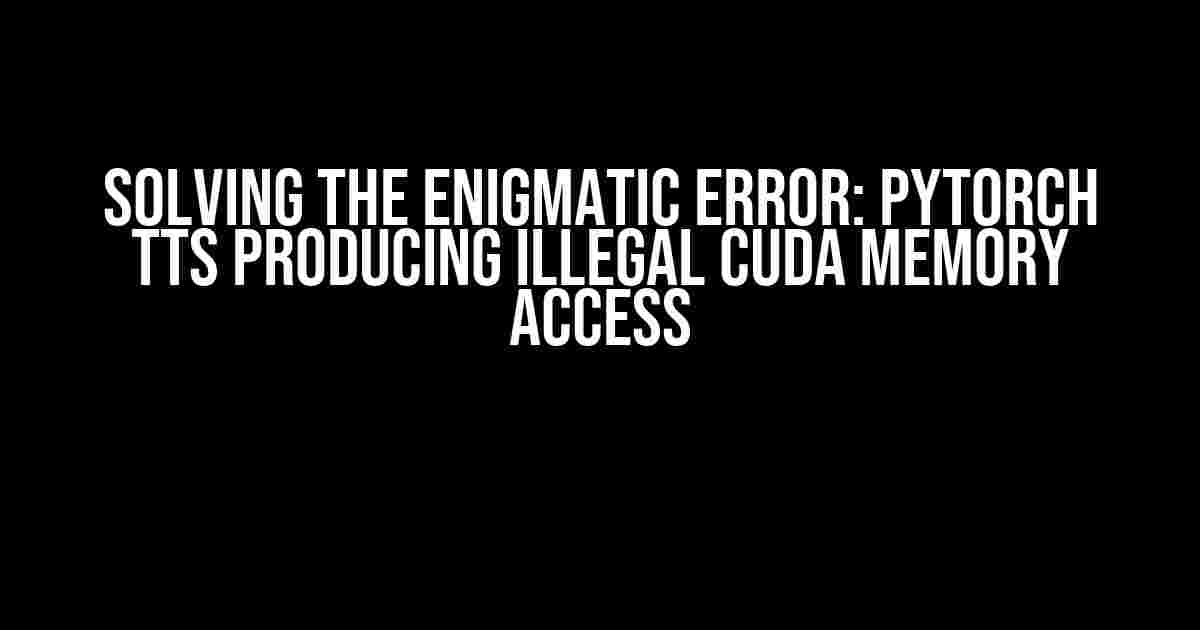Are you tired of encountering the infamous “Illegal CUDA memory access” error while working with PyTorch TTS (Text-to-Speech)? You’re not alone! In this article, we’ll delve into the causes of this frustrating issue and provide you with a comprehensive guide to troubleshoot and fix it.
What is PyTorch TTS?
Before we dive into the solution, let’s quickly cover the basics. PyTorch TTS is a powerful, open-source library developed by Facebook AI that enables models to generate high-quality speech from text inputs. It’s built on top of PyTorch, a popular deep learning framework, and leverages the power of CUDA-enabled GPUs to accelerate computations.
The Culprit: Illegal CUDA Memory Access
The “Illegal CUDA memory access” error typically occurs when PyTorch TTS attempts to access memory regions on your NVIDIA GPU that are not valid or allocated. This can happen due to various reasons, including:
- Incorrect GPU configuration
- Inadequate GPU memory
- Corrupted or outdated GPU drivers
- Malformed model architecture or inputs
- Insufficient CUDA version or compatibility issues
Diagnosing the Issue: Preliminary Checks
Before we dive into the fixes, let’s perform some preliminary checks to ensure we’re on the right track:
torch.cuda.is_available(): Verify that PyTorch can detect and use your CUDA-enabled GPU.torch.cuda.device_count(): Check the number of available GPUs and ensure you’re using the correct device.nvidia-smi: Run this command in your terminal to verify the GPU’s memory usage and availability.
Fixin’ Time: Solutions to Illegal CUDA Memory Access
Now that we’ve narrowed down the potential causes, let’s explore the solutions:
Solution 1: Update GPU Drivers and CUDA Version
Outdated or corrupted GPU drivers can lead to compatibility issues and memory access errors. Ensure you’re running the latest drivers and CUDA version:
# Ubuntu/Debian sudo apt-get update && sudo apt-get install nvidia-driver-470 # Windows Download and install the latest NVIDIA GPU drivers from the official website
Solution 2: Configure PyTorch to Use Correct GPU
Make sure PyTorch is configured to use the correct GPU device:
import torch
device = torch.device("cuda:0" if torch.cuda.is_available() else "cpu")
Solution 3: Allocate Sufficient GPU Memory
If your model requires a large amount of GPU memory, ensure you’re allocating enough resources:
import torch
device = torch.device("cuda:0" if torch.cuda.is_available() else "cpu")
torch.cuda.set_device(device)
torch.cuda.manual_seed_all(42) # Set seed for reproducibility
torch.cuda.manual_seed(42) # Set seed for reproducibility
torch.backends.cudnn.deterministic = True
torch.backends.cudnn.benchmark = False
Solution 4: Optimize Model Architecture and Inputs
Misconfigured model architectures or invalid inputs can cause memory access errors. Review your model design and input data:
import torch
import torch.nn as nn
class TTSModel(nn.Module):
def __init__(self):
super(TTSModel, self).__init__()
# Define your model architecture here
model = TTSModel()
input_data = torch.randn(1, 80, 100) # Replace with your input data
Solution 5: Disable CUDA Memory Pools
In some cases, CUDA memory pools can cause memory conflicts. Try disabling them:
import torch torch.cuda.empty_cache() torch.cuda.memory_allocated() torch.cuda.memory_reserved()
Solution 6: Reset PyTorch and CUDA
If all else fails, try resetting PyTorch and CUDA:
import torch torch.cuda.reset_max_memory_allocated() torch.cuda.reset_max_memory_cached() torch.cuda.synchronize()
Additional Tips and Tricks
To minimize the occurrence of illegal CUDA memory access errors:
- Monitor your GPU memory usage using tools like
nvidia-smiorgpustat. - Regularly update your GPU drivers and CUDA version.
- Use model parallelism and data parallelism to distribute computations across multiple GPUs.
- Profile your model using PyTorch’s built-in profiling tools to identify memory bottlenecks.
| Error Message | Solution |
|---|---|
| Illegal CUDA memory access | Update GPU drivers and CUDA version |
| Illegal CUDA memory access | Configure PyTorch to use correct GPU |
| Illegal CUDA memory access | Allocate sufficient GPU memory |
| Illegal CUDA memory access | Optimize model architecture and inputs |
| Illegal CUDA memory access | Disable CUDA memory pools |
| Illegal CUDA memory access | Reset PyTorch and CUDA |
Conclusion
PyTorch TTS is an incredibly powerful tool for generating high-quality speech from text inputs. However, the “Illegal CUDA memory access” error can be a frustrating obstacle. By following the solutions and tips outlined in this article, you’ll be well-equipped to tackle this issue and get back to experimenting with PyTorch TTS.
Remember to stay vigilant and monitor your GPU memory usage, update your drivers and CUDA version regularly, and optimize your model architecture and inputs. Happy coding, and may the speech be with you!
Frequently Asked Question
Got stuck with PyTorch TTS producing Illegal CUDA memory access? Don’t worry, we’ve got you covered! Here are some frequently asked questions to help you troubleshoot the issue:
Q1: What does “Illegal CUDA memory access” error mean?
This error occurs when PyTorch TTS tries to access memory on your NVIDIA GPU that is not valid or not allocated. It can happen due to various reasons, including incorrect model architecture, invalid input data, or incorrect CUDA installation.
Q2: How do I check if my CUDA installation is correct?
You can check your CUDA installation by running the command `nvidia-smi` in your terminal. This command should display information about your NVIDIA GPU and CUDA version. If you don’t see any output or encounter errors, it may indicate an incorrect installation.
Q3: What are some common causes of “Illegal CUDA memory access” error in PyTorch TTS?
Common causes of this error include incorrect model architecture, invalid input data, incorrect batch size, or improper CUDA device selection. Additionally, using an outdated PyTorch version or incompatible NVIDIA driver can also lead to this error.
Q4: How do I fix “Illegal CUDA memory access” error in PyTorch TTS?
To fix this error, try the following steps: (1) Check your model architecture and input data for any potential issues, (2) Ensure you are using the correct CUDA device and batch size, (3) Update your PyTorch version and NVIDIA driver to the latest compatible versions, and (4) Try reducing the batch size or model complexity to reduce memory usage.
Q5: Are there any alternative solutions to PyTorch TTS that can avoid “Illegal CUDA memory access” error?
Yes, you can consider alternative solutions like TensorFlow TTS or Google’s TensorFlow Text-to-Speech (TF-TTS) framework, which may be more robust and less prone to “Illegal CUDA memory access” errors. However, keep in mind that these alternatives may require additional setup and configuration.


